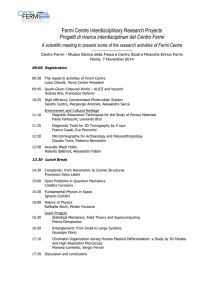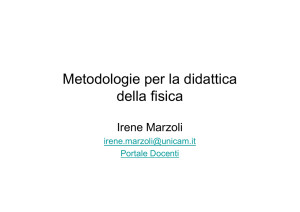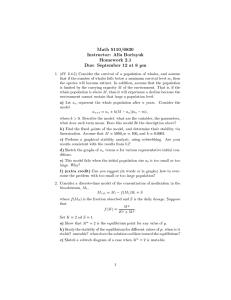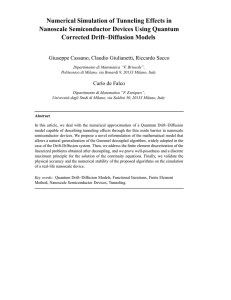8.514: 11/04/03 Quasiparticle transport
advertisement
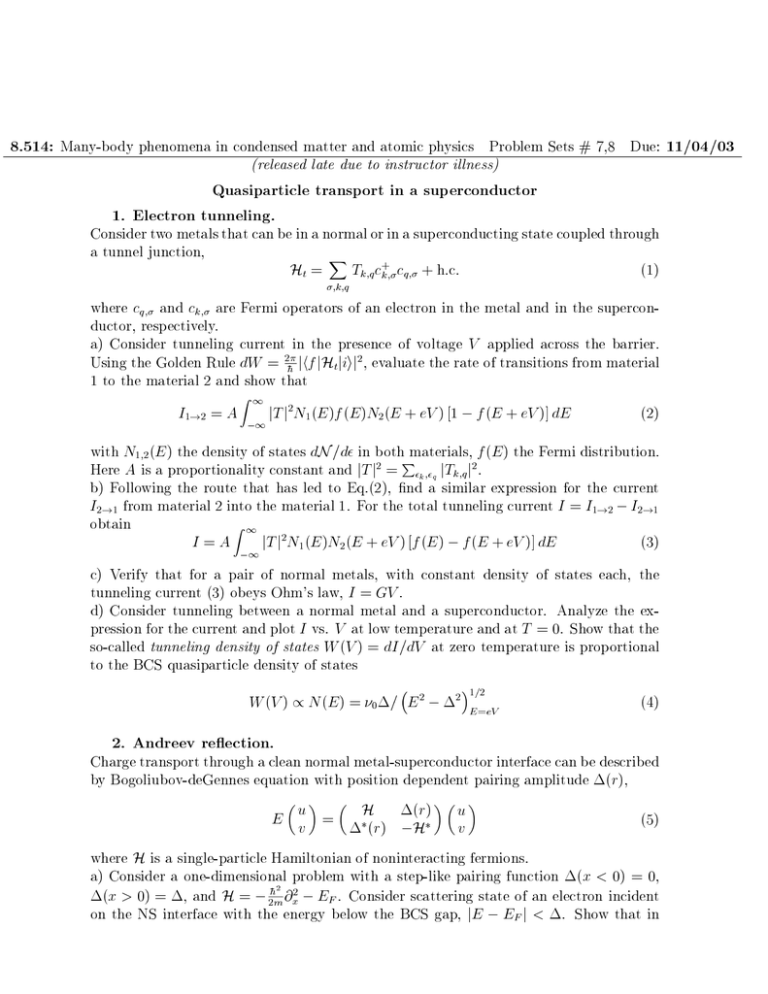
8.514: Many-body phenomena in condensed matter and atomic physics Problem Sets # 7,8 Due: 11/04/03 (released late due to instructor illness) Quasiparticle transport in a superconductor 1. Electron tunneling. Consider two metals that can be in a normal or in a superconducting state coupled through a tunnel junction, X Ht = Tkq c+k cq + h:c: (1) kq where cq and ck are Fermi operators of an electron in the metal and in the superconductor, respectively. a) Consider tunneling current in the presence of voltage V applied across the barrier. Using the Golden Rule dW = 2�h jhf jHtjiij2, evaluate the rate of transitions from material 1 to the material 2 and show that Z1 I1!2 = A jT j2N1 (E )f (E )N2(E + eV ) 1 ; f (E + eV )] dE (2) ;1 with N12 (E ) the density of states dN =d in bothPmaterials, f (E ) the Fermi distribution. Here A is a proportionality constant and jT j2 = kq jTkq j2 . b) Following the route that has led to Eq.(2), nd a similar expression for the current I2!1 from material 2 into the material 1. For the total tunneling current I = I1!2 ; I2!1 obtain Z1 I = A jT j2N1(E )N2 (E + eV ) f (E ) ; f (E + eV )] dE (3) ;1 c) Verify that for a pair of normal metals, with constant density of states each, the tunneling current (3) obeys Ohm's law, I = GV . d) Consider tunneling between a normal metal and a superconductor. Analyze the expression for the current and plot I vs. V at low temperature and at T = 0. Show that the so-called tunneling density of states W (V ) = dI=dV at zero temperature is proportional to the BCS quasiparticle density of states W (V ) / N (E ) = 0 = E 2 ; 2 1=2 E �eV (4) 2. Andreev re ection. Charge transport through a clean normal metal-superconductor interface can be described by Bogoliubov-deGennes equation with position dependent pairing amplitude (r), u H ( r ) E v = � (r) ;H� uv (5) where H is a single-particle Hamiltonian of noninteracting fermions. a) Consider a one-dimensional problem with a step-like pairing function (x < 0) = 0, 2 2 h � (x > 0) = , and H = ; 2m @x ; EF . Consider scattering state of an electron incident on the NS interface with the energy below the BCS gap, jE ; EF j < . Show that in the superconductor the solution is an evanescent wave, and in the metal it describes a reected hole. b) Now consider incident electron with the energy slightly above the gap, jE ; EF j > . Describe the result of scattering of such an electron. c) Generalize the result of part a) to a 3D system. Consider planar normal metalsuperconductor interface with an electron incident at an angle to normal. Find the direction of the outgoing hole. Fermi liquid theory 3. Thermodynamic functions, specic heat. a) Thermodynamic potential of the ideal Fermi gas can be evaluated as Z = ;T ln 1 + e;p d3p=(2h )3 (6) Starting from this expression, show that specic heat is a linear function of temperature at T EF . Find the proportionality constant in the relation C = T . b) Consider the thermodynamic potential using the particle-hole oscillator representation. We are going to check if it gives the same result as the canonical Fermi representation. In the absence of interactions, X 1 � 1 2 � H= kpkp + 2 !pkkpkp (7) kp2Rk 2 with !pk = (p + k)2=2m ; p2=2m. Apply the formula for the thermodynamic potential of an ensemble of free bosons, X � = T X ln 1 ; e;�h!pk = T ln 1 ; e;h! kp2Rk with !pk = v k + k2 =2m, v = p=m, and the crescent domain Rk dened in lecture as an overlap of a displaced Fermi sphere complement jp + kj > p0 with the undisplaced Fermi sphere jpj < p0. Compare with the result of part a). To simplify analysis, consider only low temperatures, and nd the specic heat for T EF . c) Consider thermodynamic functions of the system of interacting fermions using the oscillator representation, X Hint = Vk!p1=k2 !p1=2k�kpkp (8) kpp 2Rk Compare with the noninteracting case. Like in part b), do the calculations assuming T EF . 0 0 0 4. Screening Consider R screening of an external potential in a 3D electron gas with Coulomb repulsion Vk = (e2 =jrj)eikrd3r = 4e2 =k2 between electrons. Show that for a slowly varying potential, the screened potential is described by 2 Vk = k2 +k r;2 Vkext rs;2 = 4e2 (9) s with the density of states at the Fermi level. The quantity rs is the screening radius, as can be seen from the form of the screened Coulomb potential 1r e;r=rs .
